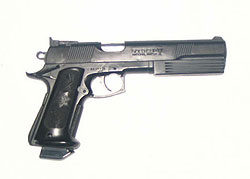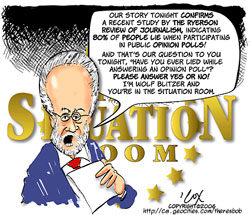Rob Roberts, the National Post‘s Toronto editor, got the news within 10 minutes. He was short-staffed – it was, after all, the day after Christmas. So he sent in what he had, two reporters and a night person. He didn’t know who was dead – if anyone – but he knew the story was big.
It’s a story we now know all too well. It’s late in the afternoon, and Yonge Street in Toronto’s downtown core is dark and crowded. Families and friends line up to take advantage of the deep discounts at Sam the Record Man’s Gould Street flagship store. Shoppers also pack the Foot Locker outlet, a Pizza Pizza and numerous electronic stores. All in all, it’s a typical Boxing Day of bargain hunting, except for one thing: gunshots are fired. Suddenly, it’s chaos. People are running up and down the street screaming. A stray bullet kills Jane Creba, a 15-year-old Grade 10 student from Riverdale Collegiate. Six others are injured in the attack.
Roberts’s plan is to run two stories in the next day’s paper. One will be a straight hard news story, while the second will provide colour by describing both the scene and the mood. Siri Agrell, one of his reporters on her day off, calls in to say she can do the colour story. Her piece, about a grief-stricken mother, is the first of many that makes Roberts proud of his paper’s coverage.
In the aftermath of the shootings, one particular phrase, the year of the gun, is used by Toronto media to assess a quickly fading 2005. Big, scary headlines and excessive memorial reportage leave the impression that the city is no longer safe. Reporters and editors, however, at four Toronto dailies- the Toronto Star, the Toronto Sun, the Globe and Mail and the Post – say the coverage was generally fair and balanced. Sometimes, it seems, even accurate coverage can’t help but ratchet up fear among the public. Roberts admits he played with a few gruesome headlines and seriously considered splashing the words “blood bath” across the front page. But in the end, he says, there was no need to play the story up – the magnitude of the event was implicit in the facts.
The Globe, like the Post, couldn’t flood the zone with coverage either. With only four or five reporters to go around, it focused three on the shootings. One, Joe Friesen, thought the calamity would bring endless doomsday headlines. “But,” he says, “the coverage was fair, balanced and appropriate.”
The Star tested the waters of panic on December 31 with the headline “2005 Year of the Gun: Is This the End?” but didn’t wade in any deeper.
Editors and reporters at the four major dailies agree that any sensationalizing of the event came from outside media like CNN, which advised viewers to beware of Toronto. The network’s Miles O’Brien even described the death toll as evidence of “a whole, you know, crime spree underway.” According to Star crime reporter Bob Mitchell, CNN portrayed Toronto as a dangerous city. “The American media made it look as if it was the next SARS,” he says.
In fact, no Toronto story has garnered this much outside attention since 2003, when Severe Acute Respiratory Syndrome claimed the lives of more than three dozen people and quarantined hundreds more. The outbreak made world news, and tourism plummeted, which hit Toronto’s economy hard. People boycotted Chinatown and were scared to go outside. Deeply discounted hotel, restaurant and entertainment packages were offered to entice tourists. The city even held a SARS benefit concert at Downsview Park in Toronto, which The Rolling Stones headlined.
Like the acronym “SARS,” “the year of the gun” is the kind of simplistic phrase with negative connotations that can linger and cause people to lose all sense of proportion. Although the number of deaths is almost double that of 2004, which saw 27 victims of gun violence, Toronto is still safer than many American cities. New York City, for example, reported 1,454 shootings last year (though not all were fatal). Toronto is not even the sole Canadian city with a gun problem. Edmonton saw 13 fatal shootings in 2005, and Vancouver police have seen a sharp increase in the number of illegal guns over the past three years.
For Friesen, the latest scare hasn’t modified his behaviour. The Toronto shootings were on his mind a few days later, when he was back in the area and thought about stopping by Creba’s memorial. But, he says, he doesn’t think people will forgo shopping in the Yonge and Dundas area the way they boycotted Chinatown during the SARS epidemic.
While it is undoubtedly true that the four papers demonstrated sensationalistic tendencies at times, they were also simply reflecting back to readers the very nature of the brazenness of the crimes. Strangely, a group that is more often than not at odds with the media believes the coverage was fair. Mark Pugash, director of communications for the Toronto Police Service, thinks the situation deserved as much attention as it received. “Anybody assessing the media,” he says, “expects that the information will have been researched and checked, and that it is accurate.”
By that definition, Pugash thinks, the Toronto media upheld their responsibility to the community.
About the author
Amanda Shuchat was the Director of Publicity for the Spring 2006 issue of the Ryerson Review of Journalism.


